Porcelain Insulator News
by Elton Gish
Reprinted from "Crown Jewels of the Wire", November 1995, page 22
The Marlborough National show was very exciting for porcelain collectors. A
lot of interesting porcelain could be found scattered around and a number of
rare insulators, too. Naturally it was close to Fred Locke country and several
different styles could be found on dealer’s tables such as several brown U-925’s,
pin bases, white U-611A, U-926A, and a Victor U-929. Mr. Douglas Fisher, a
representative from the Victor (NY) Historical Society, attended the show. He is
also the son of J. Sheldon Fisher, owner of the Valentown Museum in Fishers, NY
since the 1930’s, local historian, and Fred Locke enthusiast. Mr. Fisher’s
father furnished the “recovered Fred Locke letters” and several interesting
stories for my book, Fred M. Locke: A Biography. Mr. Fisher is working on a
display for the Victor Historical Society to honor Fred Locke, and he was
eagerly searching for Fred Locke glass and porcelain insulators to put in the
display. He bought more than 40 insulators from several dealers including a fine
example of the elusive M-2795 with original sulfur cement. The Victor Historical
Society is trying to acquire the Victor Free Library building near downtown
Victor, NY which was originally the telegraph office for the Eastern (Electric)
Rapid Railway (not where Fred Locke worked as a telegrapher). Mr. Fisher said he
would like the exhibit to have the appearance of Fred Locke’s sales office
with a display of glass and porcelain insulators, historical photographs, and
vintage insulator catalogs (I donated a dozen reprints of the 1900 and 1902 Fred
Locke catalogs). I will let you know when the Fred Locke display room is
completed.
Probably one of the most obscure items at the Marlborough show was a U-395
with a Pittsburg date control marking on top of one ear. I had spent so much
that I could not convince myself to make the modest purchase even though I have
never heard of a U-395 with any kind of marking. Luckily though it did end up in
the collection of a long-time Pittsburg collector.
Doug MacGillvary (NIA #259) has put together what is probably the most
complete collection of threadless porcelain insulators, and he is always looking
for styles he does not have. Doug picked up a new unique style at the National
which has been assigned U-973. It is a pottery insulator with a fine ash-colored
glaze. It was probably made for the Confederacy.
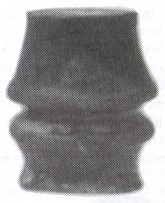
U-973

Jarl and Karen Anderson (NIA #755 & 5350) showed me an unmarked white
insulator similar to the under-glaze ink marked U-941A: it was not glazewelded
and the white speckled glazed proves it was made at Fred Locke’s Victor, NY
factory. All of the white under-glaze ink marked Fred Locke insulators were made
for him by the Electric Porcelain & Mfg. Co. in Trenton, NJ (circa
1897-1900). This new style has been assigned U-941C. Fred Locke literally marked
every porcelain insulator made at the Victor factory, so the unmarked U-941C
must have been made just after he left the company in December 1904. I would
guess that it was made circa 1905-1906. U-941C is a fine example of an insulator
that was made to duplicate an earlier glazewelded style. Jarl said that he got
the insulator from a bottle dealer in Saratoga Springs, NY sometime before 1975.
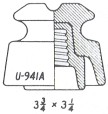
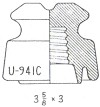
I finally got to see Joe Maurath, Jr.’s (NIA #813) unusual insulator with
the incuse “LI” marking on a raised oval. The photograph shows the marking
rather well. This very unusual insulator has been assigned U-740. The insulator
is pinkish colored and the very dull surface appears unglazed. Joe said it was
given to a small local utility back in the 1960’s along with a similar
insulator with a greenish color so they could test them in an area prone to
contamination. The utility never did run the test and the greenish insulator has
since disappeared. It seems inconceivable that an insulator with a dull,
apparently “unglazed” surface could have provided much benefit in a
contaminated service. Even minor handling of the insulator produces a dirty
appearance. I guess the utility company had its doubts, too. The meaning of the
letters ‘LI” is anyone’s guess.
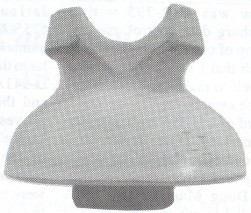
U-740
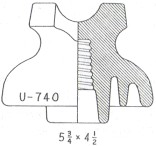
Bob Lanpher (NIA #487) had a common U-133 with the most unusual glaze I have
ever seen on an insulator. The glaze is very dark, slightly reddish brown with
light-colored spots fairly uniformly covering the entire insulator - as if it
was purposely made that way. The spots are where the glaze is thin. I cannot
imagine how this effect could have been made accidentally. We suspect that the
U-133 style was made by the Lima Insulator Co. (circa 1904-1908). Perhaps Bob’s
insulator was made by a Lima employee as a one-time art work, or could it have
been a glaze formula gone bad?
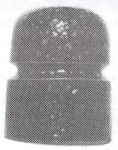
U-133 with strange
spotted glaze.
Richard Wiesman (NIA #3029) showed me an insulator with a groove or notch cut
out on both sides of the cable-top groove. It appears that the two notches may
have facilitated the use of a clamping device to hold the conductor firmly
against the crown. This insulator was reported by Richard Loeffler (Troy, NY) in
PIN in the February 1973 issue of CJ. It now has been assigned U-602. Richard’s
insulator has a slightly mottled, dark black/brown glaze and looks like it may
have been made by Thomas.
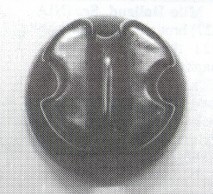
U-602 with a groove or notch cut out
on opposite sides of the crown.
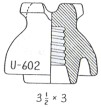
Mike McLaughlin brought a very unusual insulator to the show that no one had
ever seen before. It is M-3021. This style was not shown in my book, Multipart
Porcelain Insulators, but it was cataloged by Locke in their 1913 catalog. Their
1916 and subsequent catalogs do not show this style. Mike’s insulator was
marked with the insulator logo and VICTOR R=oo. I hope you can see the large
cutout in the ridge above the tie-wire groove in the photograph.
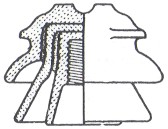
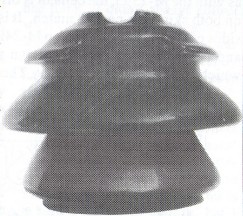
M-3021 VICTOR R=oo
7 - 6 - 3.5 x 5.5
Milo Holland, Sr. (NIA #627) brought me another M-3021 that was unmarked
(thanks Milo!). Both insulators have the same speckled rust-orange glaze typical
of Locke during the early to mid-1910’s. M-3021 is one of the smallest 3-part
insulators.
In June 1990 (CJ, page 15) we described the new, very odd multipart, M-2395.
The dimensions of this insulator are: 7.5 - 6 x 11. It was an odd style because
the long lily-shell shaped (flared) bottom skirt looked out of proportion to the
relatively small diameter top skirt. Another similar style has recently surfaced
from an old collection which I have assigned M-2495. You can see in the
photograph what I mean by a very odd looking insulator. Some people might think
that it is a fake made up of shells from two different styles, but, as with the
M-2395, the cement is original and the rust-brown glaze on both skirts is a
perfect match. It is obvious from the flat vertical sides of the “square”
crown on M-2495 that it was made by Thomas, and, in fact, it has one “blue-jean
seam” inside the bottom skirt which confirms it was made by Thomas circa
1905-1912.
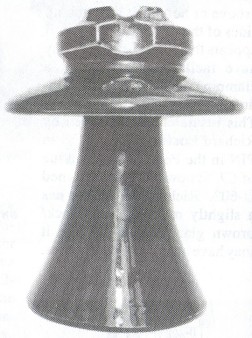
M-2495 N-N Thomas
8 - 6 x 10
| 